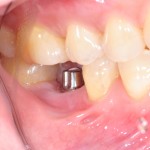
An increasing number of dental implants are being placed and peri-implantitis is a common complication with one review (Dental Elf – 15th Apr 2015) estimating a mean prevalence of 22% (CI: 14-30%). A number of studies have looked at peri-implant maintenance therapy, air-polishing and surgical treatments with or without adjunctive antibiotics.
The aim of this review was to assess the effectiveness of locally administered antibiotics in the treatment of peri-implantitis.
Methods
The review protocol was registered in PROSPERO and searches were conducted in the Cochrane Central Register of Controlled Trials (CENTRAL), Embase and PubMed databases. Randomised controlled trials (RCTs) and observational studies (cohort, case-control, and case series) published in English with a minimum follow up period of 4 months were considered. Bleeding on probing (BoP) and peri-implant probing depths (PPD) were the main outcomes. Two reviewers independently searched for and selected studies, extracted data and assessed risk of bias. Discrepancies were resolved by discussion or a third reviewer. The Cochrane tool was used to assess risk of bias in RCTs and the Joanna Briggs Institute Critical Appraisal tools for non-randomized studies. Weighted means and 95% confidence intervals (CI) were calculated, and meta-analyses conducted.
Results
- 12 studies (7 RCTs, 3 cohort/case controlled studies, 1 prospective study and 1 case series) involving a total of 365 patients and 463 implants were included.
- 6 studies evaluated minocycline application, 4 doxycycline, 1 polymeric tetracycline, 1 metronidazole, and 1 analysed doxycycline, lincomycin and erythromycin.
- 4 studies were considered to be at low risk of bias, 6 at medium risk and 2 at high risk.
- 11 studies contributed to the meta-analyses
- For the antibiotic group alone the reduction in PPD = 1.4mm (95%CI; 0.82 to 1.98) [11 studies].
- Compared to controls the antibiotic group had an additional PPD reduction = 0.3mm (95%CI; 0.07 to 0.53) [7 studies].
- The odds of BoP was higher in the control group OR = 1.82 (1.09 to 3.04) [7 studies].
Conclusions
The authors concluded: –
…existing scientific evidence suggests that the local antibiotic administration did reduce, without adverse effects, both PPD and BoP in patients affected by peri-implantitis. Clinicians can expect to obtain an additional PPD reduction of 0.30 mm, when using locally administered antibiotics, and a likelihood of bleeding on probing almost two-fold when antibiotics are not locally applied.
Comments
The reviewers have searched several major databases although restricting inclusion to English language papers may have excluded some relevant studies. However, although common the number of high-quality studies investigating treatments for peri-implantitis is small. The current review includes 12 small studies with only a total of 365 patients with just 241 of these in RCTs. So, while the findings indicate some additional benefits for PPD and BoP with the use of local antimicrobials it is debatable as to whether these are clinically important. High quality trials conducted and reported RCTs of appropriate size and follow up periods are needed to properly compare treatments for peri-implantitis.
Links
Primary Paper
Toledano M, Osorio MT, Vallecillo-Rivas M, Toledano-Osorio M, Rodríguez-Archilla A, Toledano R, Osorio R. Efficacy of local antibiotic therapy in the treatment of peri-implantitis: A systematic review and meta-analysis. J Dent. 2021 Aug 27;113:103790. doi: 10.1016/j.jdent.2021.103790. Epub ahead of print. PMID: 34455016.
Other references
Dental Elf – 15th Apr 2015
Dental Elf – Peri-implantitis blogs
